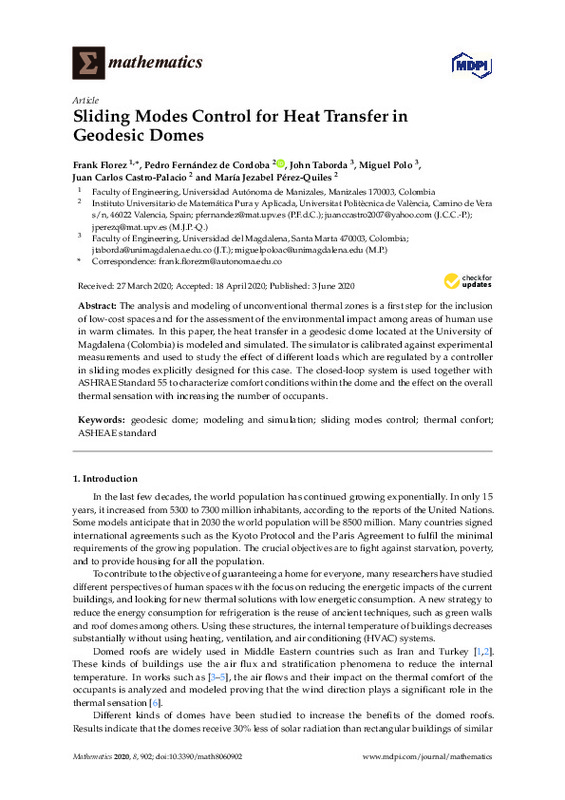Faghih, A. K., & Bahadori, M. N. (2010). Three dimensional numerical investigation of air flow over domed roofs. Journal of Wind Engineering and Industrial Aerodynamics, 98(3), 161-168. doi:10.1016/j.jweia.2009.10.012
Saka, M. P. (2007). Optimum Geometry Design of Geodesic Domes Using Harmony Search Algorithm. Advances in Structural Engineering, 10(6), 595-606. doi:10.1260/136943307783571445
Soleimani, Z., Calautit, J., & Hughes, B. (2016). Computational Analysis of Natural Ventilation Flows in Geodesic Dome Building in Hot Climates. Computation, 4(3), 31. doi:10.3390/computation4030031
[+]
Faghih, A. K., & Bahadori, M. N. (2010). Three dimensional numerical investigation of air flow over domed roofs. Journal of Wind Engineering and Industrial Aerodynamics, 98(3), 161-168. doi:10.1016/j.jweia.2009.10.012
Saka, M. P. (2007). Optimum Geometry Design of Geodesic Domes Using Harmony Search Algorithm. Advances in Structural Engineering, 10(6), 595-606. doi:10.1260/136943307783571445
Soleimani, Z., Calautit, J., & Hughes, B. (2016). Computational Analysis of Natural Ventilation Flows in Geodesic Dome Building in Hot Climates. Computation, 4(3), 31. doi:10.3390/computation4030031
Khoshab, M., & Dehghan, A. A. (2013). Numerical Simulation of Mixed Convection Airflow Under a Dome-Shaped Roof. Arabian Journal for Science and Engineering, 39(2), 1359-1374. doi:10.1007/s13369-013-0705-z
Faghih, A. K., & Bahadori, M. N. (2011). Thermal performance evaluation of domed roofs. Energy and Buildings, 43(6), 1254-1263. doi:10.1016/j.enbuild.2011.01.002
Switzerland Cernhttps://pixabay.com/en/switzerland-sky-clouds-cern-93275/
Li, T., Yan, G., Yuan, F., & Chen, G. (2019). Dynamic structural responses of long-span dome structures induced by tornadoes. Journal of Wind Engineering and Industrial Aerodynamics, 190, 293-308. doi:10.1016/j.jweia.2019.05.010
Haghighi, A. P., Golshaahi, S. S., & Abdinejad, M. (2015). A study of vaulted roof assisted evaporative cooling channel for natural cooling of 1-floor buildings. Sustainable Cities and Society, 14, 89-98. doi:10.1016/j.scs.2014.08.005
Nagarathinam, S., Doddi, H., Vasan, A., Sarangan, V., Venkata Ramakrishna, P., & Sivasubramaniam, A. (2017). Energy efficient thermal comfort in open-plan office buildings. Energy and Buildings, 139, 476-486. doi:10.1016/j.enbuild.2017.01.043
He, Y., Chen, W., Wang, Z., & Zhang, H. (2019). Review of fan-use rates in field studies and their effects on thermal comfort, energy conservation, and human productivity. Energy and Buildings, 194, 140-162. doi:10.1016/j.enbuild.2019.04.015
Ryzhov, A., Ouerdane, H., Gryazina, E., Bischi, A., & Turitsyn, K. (2019). Model predictive control of indoor microclimate: Existing building stock comfort improvement. Energy Conversion and Management, 179, 219-228. doi:10.1016/j.enconman.2018.10.046
Ulpiani, G., Borgognoni, M., Romagnoli, A., & Di Perna, C. (2016). Comparing the performance of on/off, PID and fuzzy controllers applied to the heating system of an energy-efficient building. Energy and Buildings, 116, 1-17. doi:10.1016/j.enbuild.2015.12.027
Florez, F., Fernández de Córdoba, P., Higón, J. L., Olivar, G., & Taborda, J. (2019). Modeling, Simulation, and Temperature Control of a Thermal Zone with Sliding Modes Strategy. Mathematics, 7(6), 503. doi:10.3390/math7060503
[-]









